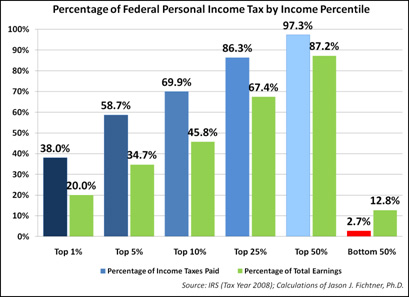A Ponzi scheme is unsustainable because the returns it promises are backed, not by any underlying productive investment, but solely by the scheme’s ability to recruit an ever increasing number of new suckers to contribute to it. … The numbers are well-known, and Charles Krauthammer rehearses them succinctly:
- “When Social Security began making monthly distributions in 1940, there were 160 workers for every senior receiving benefits.
- In 1950, there were 16.5;
- today, three;
- in 20 years, there will be but two.”
Krauthammer describes the results. To keep the scheme going, the amount that has to be wrung out of each new victim keeps increasing:
- “in 1940, the average worker had to pay only 0.2 percent of his salary to sustain the older folks of his time;
- in 1950, 2 percent;
- today, 11 percent;
- in 20 years, 17 percent.”
Correspondingly, what each new contributor gets back from the program keeps decreasing. As Andrew Biggs observes, this is another thing that Social Security has in common with a Ponzi scheme.
… the fact that Social Security can coercively recruit new contributions makes it worse. At least a private Ponzi scheme is self-liquidating. It collapses the moment its victims realize they are being defrauded. Social Security is a Ponzi scheme with no escape…
… “We paid into Social Security,” “It’s not an entitlement, it’s ours,” and, “That’s my money that I put into Social Security—I deserve it.”
These people are the victims of an enormous, decades-long swindle, because the economic reality is that the money they paid into Social Security is long gone—and the legal reality is that the benefits they think they are owed do not belong to them. Court rulings have affirmed that the government isn’t obligated to pay them any definite amount, only whatever Congress chooses to pay.
The awful truth is that Social Security’s beneficiaries … are in reality just another faction of welfare recipients. …
If Social Security is actually a welfare scheme, then it is the most unnecessary welfare program in history. The system’s primary beneficiaries are members of the middle class. Yet the middle class is, by definition, that segment of a society that does not need welfare. The defining characteristic of the middle class—what differentiates the middle class from the poor—is that they are prosperous enough to pay their own bills and to be independent and self-sustaining.
… the fraud of Social Security turns an independent, economically self-sufficient majority into just another welfare-state pressure group.
If you think this is an accident or an “unintended consequence,” think again. The defenders of Social Security have fought … so hard against “means testing” that would reduce the benefits paid to the more well-off, and that is why politicians voted to expand Social Security benefits in 1970s…
That leads us to the final evil of Social Security: the destruction it has wreaked on our very form of government. As Robert Samuelson recently observed, “In 1960, national defense was the government’s main job; it constituted 52 percent of federal outlays. In 2011—even with two wars—it is 20 percent and falling. Meanwhile, Social Security, Medicare, Medicaid and other retiree programs constitute roughly half of non-interest federal spending.” The dominant business of the federal government used to be protecting our lives and property. Now the federal government’s main job is sending checks to people who don’t work.
So we have a system that is fraudulent and unsustainable in its design, which suppresses capital accumulation for individuals and economic growth for the economy as a whole, and which reduces a self-sufficient majority to supplicants of the state. The whole system is intellectually dishonest, economically destructive, and morally corrupting.
A mere Ponzi scheme? We should be so lucky.
We will need to have a “national discussion,” to use the standard politician’s phrase, about the best and most politically palatable way to unwind this scheme. But it is a fraud and a monstrous lie, and the sooner we tear it down, the better.





